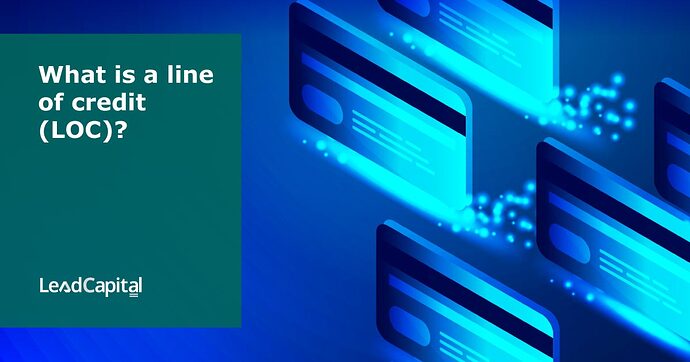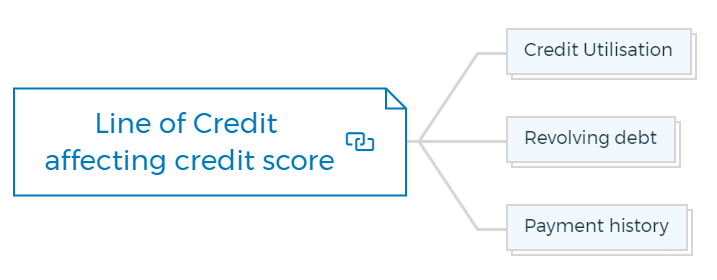What is a line of credit (LOC)?
Understand what a line of credit (LOC) is or how it works and get access to cash when you need it.
Understanding line of credit (LOC)
A Line of Credit (or LOC) is a type of loan that gives you access to a predetermined amount of money. The lending institution sets the maximum limit, and you can withdraw as much or as little as you need up to that limit.
You don’t have to use all the funds at once but only borrow what you need when the time comes.
You are missing out if you haven’t yet subscribed to our YouTube channel.
What are the different types of line of credit?
Each Line of Credit has its unique combination of features and benefits to suit different needs. The two main types of Lines of Credit are secured and unsecured.
Secured Line of Credit
A secured Line of Credit, such as a Home Equity Line of Credit (HELOC), links your line of credit to something you own, like your home or other property.
This type of Line of Credit offers a higher credit limit, lower interest rates and access to larger sums of money.
An unsecured line of credit
An unsecured Line of Credit doesn’t require you to provide collateral but may have a slightly lower credit limit and higher interest rates than a secured Line of Credit.
The funds are usually available more quickly than with a secured Line of Credit, making it a good choice if you need immediate access.
A Line of Credit provides flexibility and convenience when you need short-term cash or financing. You can use it for various needs, such as home improvements, debt consolidation, medical bills, etc.
Property Development Books - “Starter-Pack”
18 Property Development Books To Get You Started Now
Includes 18 x detailed eBooks
✓ Property Development Checklist - 6 Pages
✓ How To Finance Your Property Development Project? - 13 Pages
✓ Property Development Team - 19 Pages
✓ Site Acquisition Process - 14 Pages
✓ The Ultimate Guide To Getting Started In Property Development - 42 Pages
✓ My Secret Property Development Process - 28 Pages
✓ How To Nail Your Next No Money Down Deal? - 29 Pages
✓ Industry Insiders Guide To Managing Risks In Property Development - 26 Pages
✓ How To Become A Property Developer? - 41 Pages
✓ Do You Have What It Takes To Be A Property Developer? - 12 Pages
✓ 7 Common Mistakes Made By Property Developers & How To Avoid Them? - 12 Pages
✓ 5 Reasons, Buy & Hold Property Investors Fail At Property Development - 16 Pages
✓ 10 Financial Mistakes Made By Property Investors & Developers - 54 Pages
✓ My 26 Question Due Diligence Checklist - 21 Pages
✓ Property Development 101: The Feasibility Study - 34 Pages
✓ Property Development 101: Construction Guide - 55 Pages
✓ Property Development Blueprint - 66 Pages
✓ Your Definitive Guide To Property Options - 36 Pages
What is the difference between a line of credit and a loan?
- The biggest difference between a Line of Credit and a loan is that a Line of Credit allows you to withdraw funds as needed, up to your pre-set credit limit. With a loan, you receive the total amount upfront and must then pay it off in fixed installments over time.
- Unlike a loan, which has an end date and a set repayment schedule with fixed payments, Line of Credit funds typically remain available until the credit limit is reached. You can also make additional repayments any time to reduce your balance faster and save on interest charges.
- A Line of Credit offers more flexibility than a loan but may have higher interest rates due to its unsecured nature. It is ideal for people who need emergency funds or access to short-term cash but don’t want to take out a loan.
How does a Line of Credit affect my credit score?
Credit Utilisation
Credit utilisation, also referred to as revolving utilisation, shows the relationship between the balance and limits of credit cards.
How you manage your revolving accounts greatly impacts your credit scores. Nearly 30% of your FICO score is based on your credit utilisation.
A huge credit card balance can reduce your credit scores even with on-time payments if it increases your credit utilisation ratio.
You can calculate your credit utilisation ratio by dividing your total credit limits by the total debt on credit cards.
For example, if you have credit limits of up to $50,000 and your total debt is $5,000; then your credit utilisation is 10%.
Revolving debt
Revolving debt adds a line of credit to your credit report, which can raise your credit score if you keep the balance low or pay it off regularly. However, if you carry a high balance from month to month, that could lower your score.
Payment history
Many credit score models consider payment history for calculating your credit scores.
Opening a line of credit and paying on time may boost your credit score. If you make occasional late payments, that same line of credit could damage your scores.
Property Finance Made Easy
We specialise in Development funding | Commercial finance | Construction loans | Portfolio refinancing & Property investment loans in Australia.
Click Here to strategise with Amber






